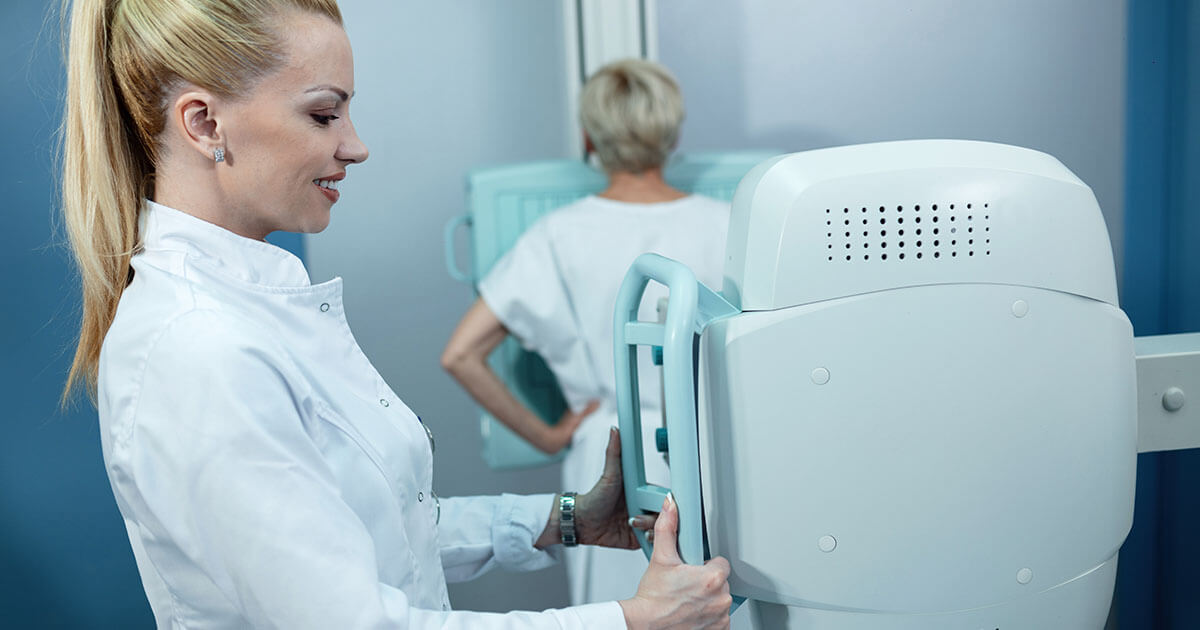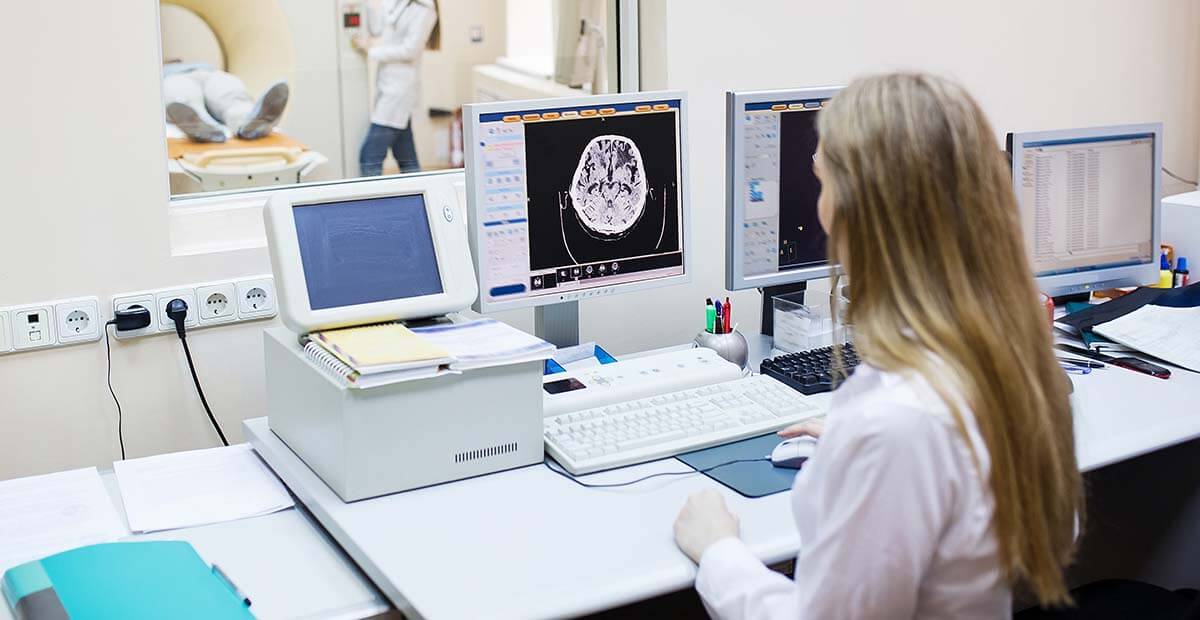
We collect basic website visitor information on this website and store it in cookies. We also utilize Google Analytics to track page view information to assist us in improving our website.

Ergonomic workstations are essential for radiologists to ensure their comfort, well-being, and productivity while minimizing the risk of work-related injuries.
By providing a supportive and ergonomic environment, radiologists can focus on their critical work of diagnosing and treating patients effectively.
An ergonomic workstation in radiology refers to a setup that is designed to optimize the working conditions and reduce the physical strain placed on radiologists while interpreting medical images.
It involves the arrangement of furniture, equipment, and accessories in a way that promotes comfort, proper posture, and efficient workflow.
A radiologist performs a variety of tasks throughout the course of a workday. These tasks typically involve the interpretation and analysis of medical images to aid in diagnosis and treatment planning.
It's important to note that the specific tasks performed by radiologists can vary depending on the subspecialty they specialize in (e.g., neuroradiology, musculoskeletal radiology, or cardiovascular radiology) and the setting in which they work (e.g., hospitals, clinics, or academic institutions).
Here are some common tasks that radiologists engage in:
Radiologists review and interpret various types of medical images, including X-rays, CT scans, MRI scans, ultrasounds, and mammograms. They analyze the images to identify abnormalities, assess the extent of diseases or injuries, and make accurate diagnoses.
Based on their analysis of medical images, radiologists provide diagnostic reports detailing their findings. They identify and describe any abnormalities or abnormalities they observe, such as tumors, fractures, infections, or other medical conditions.
Radiologists often collaborate with other healthcare professionals, such as referring physicians or specialists, to discuss imaging findings, provide insights, and assist in developing appropriate treatment plans. They may provide additional guidance or recommendations based on their expertise in imaging.
Some radiologists perform minimally invasive procedures that involve image-guided techniques. These procedures may include biopsies, drainages, catheter placements, or therapeutic interventions. Radiologists use imaging technology to guide their instruments and ensure precise placement during these procedures.
Radiologists participate in quality control activities to ensure the accuracy and reliability of the imaging process. This may involve reviewing and monitoring image quality, providing feedback to radiology technologists, and ensuring compliance with established protocols and standards.
Many radiologists engage in research activities to advance the field of radiology. They may conduct studies, publish scientific articles, or present at conferences. Additionally, radiologists often participate in educational activities, such as teaching medical students, residents, or fellows, and staying updated with the latest advancements in radiological techniques and technologies.
Radiologists may have administrative responsibilities, such as overseeing the operations of a radiology department, managing personnel, participating in quality improvement initiatives, and ensuring compliance with regulatory requirements.

As you can see, a radiologist can have many responsibilities during their workday. A properly designed ergonomic workstation and Reading room needs to consider the different activities and how often the radiologist engages in those activities.
Ergonomic workstations are important because they prioritize employee health, enhance productivity, prevent injuries, increase comfort, reduce fatigue and stress, offer long-term health benefits, and contribute to employee retention and attraction.
By investing in ergonomic design, organizations can create a healthier and more productive work environment for their employees. Here are some key benefits to having ergonomic workstations for your radiology team:
Comfort and Well-being: Radiologists spend long hours sitting at their workstations, analyzing images and reports. Ergonomic setups ensure comfort and reduce the risk of developing musculoskeletal disorders, such as back pain, neck strain, and carpal tunnel syndrome. By providing proper support and alignment, ergonomic workstations promote overall well-being and reduce discomfort.
Productivity and Efficiency: Radiologists require focus and concentration to accurately interpret medical images. An ergonomic workstation optimizes their productivity by minimizing distractions and physical discomfort. By reducing the likelihood of fatigue and discomfort, ergonomic setups help radiologists maintain their concentration and work efficiently.
Posture and Spinal Health: Radiologists often have to view monitors, manipulate equipment, and perform repetitive tasks. Ergonomic workstations encourage proper posture and spinal alignment, preventing strain on the neck, shoulders, and back. This helps maintain a healthy spine and reduces the risk of chronic pain or spinal conditions.
Eye Strain and Visual Fatigue: Radiologists rely heavily on visual information, examining detailed images for extended periods. Ergonomic workstations consider factors such as monitor placement, lighting, and glare reduction. Proper positioning and appropriate lighting minimize eye strain and visual fatigue, allowing radiologists to work comfortably and effectively.
Enhanced Focus and Accuracy: Discomfort and distractions can hinder concentration and decrease accuracy. Ergonomic workstations reduce physical strain, allowing radiologists to focus on the task at hand and make precise diagnoses. By minimizing discomfort and optimizing working conditions, ergonomic setups contribute to improved accuracy in radiological interpretations.
Injury Prevention: Repetitive tasks and awkward positions can lead to repetitive strain injuries (RSIs) and work-related musculoskeletal disorders (WRMSDs). Ergonomic workstations mitigate these risks by providing adjustable furniture, ergonomic accessories, and promoting proper body mechanics. This helps prevent injuries and the associated long-term health consequences.
Retention and Attraction of Talent: Providing ergonomic workstations demonstrates an organization's commitment to the well-being and comfort of its employees. This can enhance employee retention and attract top talent. Job seekers increasingly value workplaces that prioritize health and employee satisfaction, and ergonomic workstations contribute to creating an appealing work environment.
By implementing an ergonomic workstation, radiologists can reduce the risk of developing work-related musculoskeletal disorders (WRMSDs), improve comfort, enhance concentration, and promote overall well-being, thus enabling them to perform their tasks more effectively and efficiently.

What exactly makes a workstation ergonomic? Here are some key components of an ergonomic workstation for radiologists:
An ergonomic workstation should have a height-adjustable desk and an adjustable chair to accommodate individual preferences and promote proper posture. The desk height should be set to ensure that the monitor is at eye level, and the chair should provide adequate lumbar support.
The positioning of the monitor is crucial for an ergonomic workstation. The monitor should be placed directly in front of the radiologist, at eye level, and at an appropriate distance to reduce eye strain and neck discomfort. Multiple monitors may be used to display different sets of images simultaneously.
Ergonomic keyboards and mice can help reduce strain on the wrists and hands. These accessories are designed to promote natural hand and arm positions, reducing the risk of repetitive strain injuries (RSIs) such as carpal tunnel syndrome. They should be placed at a comfortable distance and angle from the radiologist.
Proper lighting is essential to prevent eye fatigue. The workstation should have sufficient ambient lighting that is not too harsh or dim. Additionally, measures should be taken to minimize glare on the monitor, such as adjusting the screen position, using anti-glare filters, or positioning the workstation away from direct sources of light.
A document holder can be used to hold patient records or other documents at eye level, reducing the need for constant neck and head movement. This promotes a more ergonomic reading position and minimizes strain on the neck and upper back.
Wrist supports can be used to maintain a neutral wrist position while typing or using the mouse, reducing the risk of wrist and forearm injuries. Footrests or adjustable footstools can provide support and promote proper leg and foot positioning.
The layout of the radiology reading room should be designed for easy access to imaging equipment, such as monitors, keyboards, and diagnostic tools. This minimizes unnecessary stretching or reaching, allowing radiologists to maintain a comfortable and efficient workflow.

Customizing workstations to individual radiologists is of utmost importance for several reasons. Ergonomic workstations play a crucial role in ensuring radiologists' comfort, well-being, and productivity while minimizing the risk of work-related injuries.
By providing a supportive and ergonomic environment, radiologists can focus on their critical work of diagnosing and treating patients effectively.
An ergonomic workstation in radiology refers to a setup that optimizes working conditions and reduces physical strain. It involves the arrangement of furniture, equipment, and accessories in a way that promotes comfort, proper posture, and efficient workflow.
Radiologists perform a variety of tasks throughout the course of a workday, including reviewing and interpreting medical images, providing diagnostic reports, collaborating with other healthcare professionals, performing image-guided procedures, engaging in research, and participating in quality control activities.
Ergonomic workstations are important because they prioritize employee health, enhance productivity, prevent injuries, increase comfort, reduce fatigue and stress, offer long-term health benefits, and contribute to employee retention and attraction.
By investing in ergonomic design, organizations create a healthier and more productive work environment for their radiology team.
When it comes to designing an ergonomic workstation, there are key components to consider. These include adjustable desks and chairs, proper monitor placement, ergonomic keyboards and mice, lighting and glare reduction, document holders, wrist supports and footrests, and a well-planned room layout.
RedRick Technologies is a reputable company that specializes in designing ergonomic workstations, and their expertise can be utilized to create a workstation tailored to the specific needs of radiologists.